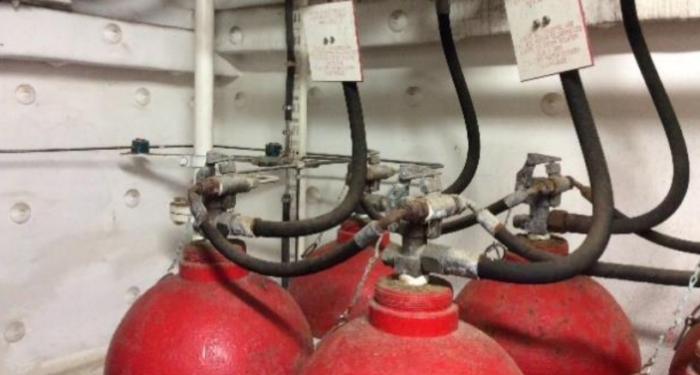The UK Maritime & Coastguard Agency informed of two serious and potentially near fatal accidental CO2 releases on UK ships in the last two years. In both cases the CO2 leaked from the manifold into the CO2 room.
Namely, the remote release valves were untouched and the CO2 alarms operated, alerting the crew and averting fatalities. However, these incidents follow a concerning pattern of similar incidents.
[smlsubform prepend=”GET THE SAFETY4SEA IN YOUR INBOX!” showname=false emailtxt=”” emailholder=”Enter your email address” showsubmit=true submittxt=”Submit” jsthanks=false thankyou=”Thank you for subscribing to our mailing list”]
UK MCA reminds operators that CO2 is highly asphyxiating, a 9% concentration causes unconsciousness within minutes and 17% causing death within just a couple of minutes. CO2 is also both colourless and odourless.
A recent UK MAIB investigation found the following:
- Many systems are designed such that a single leaking valve can discharge the entire system;
- Lack of clarity on life/service intervals and maintenance requirements of cylinder valves;
- There is perceived over reliance on shore-based contractors who may have poor knowledge of the specific system fitted onboard;
- CO2 leaked from the systems and was not contained by the pipework and manifold.
But this is not enough. UK MCA also presented some key areas that should be highlighted and can reduce the risk of similar incidents.
- When bottles are required to be refilled, it is important that valves should be either serviced or replaced at least in line with manufacturers recommendations. With regards maintenance of the valves the MCA and MAIB would like to draw the attention of service agents and ships operators to BS EN ISO 22434:2011 – Transportable gas cylinders – Inspection and maintenance of cylinder valves which provides relevant guidance on the issue of maintenance where manufacturers are silent on the issue;
- MCA interpretation of MSC.1/Circ.1318 requires that 10% of high pressure CO2 cylinders are hydrostatically tested at their 10 year anniversary. Furthermore, in line with BS EN 1968-2002 – All remaining cylinders must be hydrostatically tested by the 20 year anniversary;
- Flexible pipework must be replaced at intervals specified by the manufacturer or at the 10 year anniversary whichever is sooner as per MSC.1/Circ.1318;
- The IMO FSS Code, chapter 5.2.1.1.3 requires that crew should be checking quantities of fire extinguishing medium. Given the numbers of bottles involved, methods such as weighing of cylinders are highly impractical. There are now commonly available simple methods such as ultrasonic liquid level gauges which facilitate easy in situ level testing which operators should consider in order that their crews can readily and safely check the levels of CO2 thus enabling early detection of a potential problem. The UK would consider this appropriate as per the IMO FSS Code Chapter 5.2.1.1.3 and this could be built into the planned maintenance system;
- The MCA would remind operators of the benefit of marking the cylinders and checking CO2 levels at least annually;
- The MCA would also recommend that operators test and ensure the correct operation of any pressure switches and alarms within their systems.





























































is this correct that they state 10% at 10 years and remaining 90% at the 20 years ? Also IMO 1318 refers to Annual and Bi-Annual only, no 5 and 10 yearly intervals are mentioned correct ? These are mentioned in the IMO 1432.